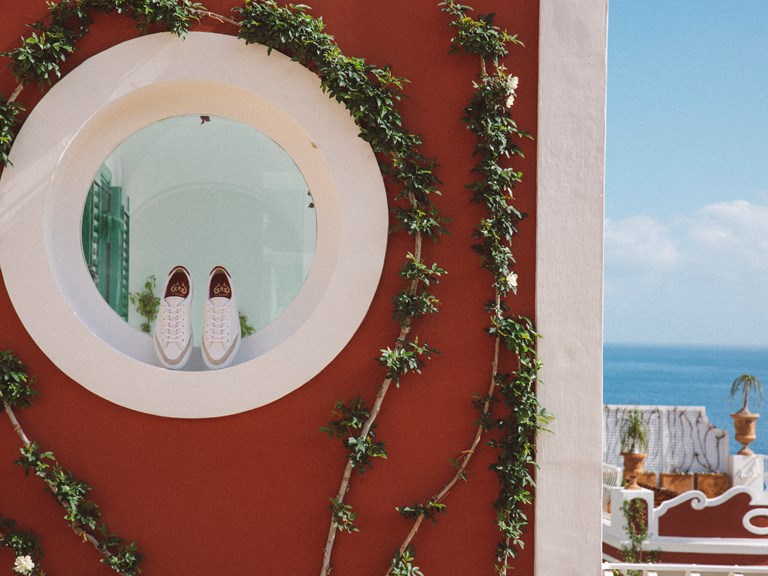POMODORO, UNA PASSIONE
04.08.2023 LE SIRENUSE
But it was such a beautiful object, in its aqua blue livery, that it seemed a shame to leave it all alone to make its way in the world. Further small volumes followed: a Positano colouring book, a collection of aphorisms on the theme of love, a book dedicated to the opening of Franco’s Bar in 2015 and the artists and craftspeople that worked on it.
We can safely say, however, that Pomodoro – the latest addition to the Le Sirenuse Little Books series – is our most ambitious yet. With texts by travel writer Lee Marshall and illustrations by Neapolitan artist Anna Monaco (a.k.a. Anouk), it is the first of a planned series on the iconic ingredients of Naples and the Amalfi Coast. Next up, in 2024: Limone. To secure your copy of Pomodoro, come and stay with us in Positano. We couldn’t possibly give you a book about tomatoes without also offering the chance to sample some of chef Gennaro Russo’s winning ways with the fruit (or should that be ‘vegetable’?). In the meantime, however, here is a short extract, all about Italy’s love affair with the plump red globe – which has not been going as long, historically speaking, as you might imagine

View
On the last day of October 1548, Cosimo de’ Medici’s steward brought him and his guests a basket of exotic hothouse produce from the grand duke’s estate at Torre del Gallo, near Florence. Writing later to the Medici private secretary, the steward described how the ‘pomidoro’ had arrived safely.
This is the first recorded use of the word in Italian. Pomodoro is derived from pomo d’oro – literally, ‘fruit of gold’. For centuries, the plural form varied wildly: pomi d’oro, pomidoro and pomidori were all common. Only recently did today’s ‘official’ plural pomodori gain the upper hand. There are still several regional variations on the standard Italian term. In Piedmont, the tomato is tomate, in Lombardy tomatesa, in Sicily pumaramuri, and in Naples pummarolo.
As for that basket of tomatoes, there’s no evidence that Cosimo and his guests did any more than look in wonder at these strange fruits. They had only arrived in Europe a couple of decades earlier, thanks to seeds brought back from Mexico by the conquistadors, and it was only in 1544 that a Sienese physician, Pietro Andrea Mattioli, suggested that this “species of eggplant”, as he referred to it, might be edible.
More than two centuries would pass before Italians took Mattioli up on his suggestion, and the tomato began to make an appearance on the dinner table. The fruit (or is it a vegetable?) was given a bad press by most botanists and herbalists, with Costanzo Felici writing in the late 1560s that it was eaten only by “gluttons and those eager for new things”. Another problem was the fact that these early tomatoes were acidic and sour: sweetness had not yet been bred into them.

It was only in the eighteenth century that the tomato secured its place in the Italian kitchen. It did so especially in the south, thanks to the Spanish influence of the Aragon and Bourbon monarchs who ruled the Kingdom of Naples almost continuously from 1442 to 1861. Some of the first tomato recipes to appear in print in Italy featured in Lo scalco alla moderna, a book by the Spanish viceroy’s kitchen steward Antonio Latini that was published in 1698. They are remarkably modern in their refinement – two involve roasting tomatoes in the embers of a fire to enhance their flavour before adding them to a sauce.
By the beginning of the nineteenth century, tomatoes had lost their exotic aura and become staples of the Italian peasant diet. New varieties began to appear, including a pear-shaped cultivar called the peretto (‘little pear’). But the marriage between pasta and tomato sauce – perhaps the archetypal image of la cucina italiana – took a while to consumate. When Goethe visited Naples in 1789, he reported that “macaroni… is simply cooked in water and seasoned with grated cheese”. The first recipe for vermicelli a pomodoro appeared in 1837, and by 1858, a guide to Neapolitan tavernas listed the two favourite pasta toppings as meat sauce and tomato sauce.

View
The latter was by this time available year round, as tomatoes from the summer glut were preserved using methods that ranged from salting and drying (widespread in Sardinia) to the preparation of various types of conserve or paste – the most common of which was the strained, semi-concentrated sauce known as passata. So popular was passata by the early twentieth century that housewives in the malarial lowlands between Rome and Naples would remove the mosquito window screens the government had fitted in their houses, and use them as strainers for tomato sauce.
The industrialisation of tomato processing soon saw the Italian pomodoro being consumed worldwide – especially in the United States, which accounted for almost half of all Italian tomato paste exports between 1905 and 1929. Even where local tomatoes were canned or bottled, as in California in the 1920s and 1930s, it was often Italo-American entrepreneurs like Lorenzo Zerillo of the River Bank Canning Company who dominated the business.
The British also went tomato mad in the first quarter of the twentieth century, and were responsible for the development of a variety that is today considered one of the most archetypal of all pomodori italiani. UK consumers preferred canned whole tomatoes to concentrated pastes, and the San Marzano, a cross between the Re Umberto and the Fiaschetto, turned out to be ideal for this purpose. The British contribution to the rise of a variety considered to be authentically Italian is one of many ironies in the long history of tomato cultivation and consumption. Another is the belief current among many American and Australian tomato fans that the popular ‘Roma’ is an Italian heirloom variety. In fact, it was developed at the Plant Industry Station in Beltsville, Maryland, in the mid-1950s.

Italians today consume as many tomatoes as ever before, but the image of the ‘fruit of gold’ is no longer simple, innocent, untarnished. Two factors have complicated it in recent years. One is the exploitation of African migrant workers in the tomato fields of southern Italy. The other is horticultural, connected with the breeding of tomatoes for long-life conservation, resistance to diseases, size and appearance rather than taste. But in Italy, as elsewhere, certain consumers are becoming more proactive, choosing to pay a little more for locally-grown heirloom varieties, or for preserves from companies that treat their pickers decently. Founded in 1986 by Carlo Petrini, the Slow Food movement has been an important force in raising awareness of traditional produce cultivated in sustainable, responsible fashion. Today, in the Naples area alone, three heirloom varieties of tomato are protected either by Slow Food’s ‘presidium’ status or the European Union’s Protected Designation of Origin quality-control label.

View
Italian author Pietro Citati looked back to a time, in his youth, when ‘Tomatoes still had a taste’, in a much-discussed article of that name that he wrote for the La Repubblica newspaper in 2006. But despite all the new supermarket-friendly cultivars, Italy is still one of the best countries in the world to find tomatoes that do have a taste. If you need convincing, try sampling an antico pomodoro di Napoli, grown on the fertile slopes of Mount Vesuvius, or a cuore di bue (ox heart), a ribbed red-green variety that makes the perfect insalata caprese when sliced and united with oozing slabs of buffalo mozzarella, fragrant basil leaves and tangy extra-virgin olive oil.
Words: Lee Marshall
Illustrations: Anouk
Le Sirenuse Newsletter
Stay up to date
Sign up to our newsletter for regular updates on Amalfi Coast stories, events, recipes and glorious sunsets


